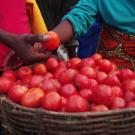This 3-page fact sheet describes how various types and sizes of crates can be used to effectively transport fresh produce, including cost benefit analysis. This document was created as part of the Horticulture Innovation Lab project focused on reducing postharvest loss in Rwanda.
Plastic crates minimize postharvest losses of fresh fruits and vegetables that can occur when produce is moved, minimizing bruising, crushing, and other damage. Plastic containers are less fragile than cardboard or wood containers, which can also absorb product moisture.
Comparison of vegetable crates by size and type
Each crate's interior dimensions, exterior dimensions, weight, capacity and truck capacity are listed in the fact sheet.
Large harvest crates: These crates can handle years of use and possess vented sides and a smooth interior which protects produce. They stack easily and are efficient to load into trucks. They are best for big growers and for transporting crops like tomatoes, onion and cabbage.
Medium harvest crates: These crates are lightweight and durable. They can handle years of use and like large harvest crates have smooth interiors, vented sides and stack easily. They can be efficiently loaded onto trucks.
Smaller harvest crates: These crates are best suited for smallholder and medium growers. They are lightweight and durable and also have a smooth interior, vented sides and stack easily. They are ideal for transporting tomatoes on a truck.
Nestable and stackable harvest crates: These crates are lightweight and durable and can handle years of use. They have a smooth interior, vented sides for optimal cooling and stack easily and quickly. They are easy to efficiently load onto trucks and can be stored economically in small spaces.
Cost benefit analysis of using crates versus woven sacks or traditional baskets
Researchers working on this project performed a cost benefit analysis to determine the benefits of using plastic crates in comparison to woven baskets to transport tomatoes in Rwanda. Using crates reduced postharvest losses from 40 percent with the woven sacks to 5 percent with the crates. Woven sacks are generally used two times, while the plastic crates could be reused more times. After one use, the cost of the plastic crate would be fully repaid.
The researchers also compared the use of plastic crates to the use of traditional baskets in a cost-benefit analysis also focused on tomatoes. The crates reduced postharvest transportation losses from 30 percent with traditional baskets down to 5 percent with plastic crates. The cost for the crates would be fully repaid after just one use.

